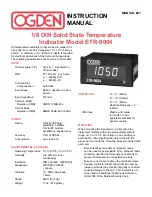
Page 41 of 49
TTI-22 Iss.04– 11/15
Calibration of industrial platinum resistance thermometers
The equations and constants defined in DIN IEC 751 are used to classify sensors with regard to their highest
permissible deviations. In this way, DIN sensor replacement without any on-site calibration is possible.
Uncalibrated sensors are not suitable for high-precision temperature measurements – at 0 °C they already
feature an allowed deviation of several tenths of degrees Celsius.
Thus, new solutions were called for. Based on many years of experience, it was found that industrial sensors
with a considerably higher accuracy (10mK) over a wide temperature range can be produced and calibrated.
To achieve this accuracy, the sensors have to be compared to reference thermometers at three or four
certain temperatures. The equation used in DIN IEC 751 for determining the basic values is then set to
these measuring points. This gives individual parameters R0, A, B and/or C for each sensor.
Example:
You require a platinum resistance thermometer for the range of 0-200 °C. The thermometer is compared
to a high-precision reference thermometer at 0 °C, 100 °C and 160 °C. With the three measuring points and
the equation
R
t
= R
0
[1 + At + Bt
2
]
the parameters R
0
, A and B are determined.
For calibration plausibility the calibrated platinum resistance thermometer is compared to the reference
thermometer at 60 °C too. From the correlation of the temperatures at this point the measuring uncertainty
of the thermometer between the calibration points can be determined.
A sensor calibrated in this manner together with a TTI-22 can achieve measuring uncertainties of <10mK in
the calibrated range.
The total measuring uncertainty largely depends on the calibration of the sensor; the measuring uncertainty
of the high-precision thermometer TTI-22 is negligible.
D.2
International Temperature Scale 1990 (ITS-90)
11 temperature ranges of ITS-90 are implemented in the instrument. Find further details on this
temperature scale in technical literature.
Table 11.1: Calibration points and parameters for the temperature ranges 1 through 4 (in K) (T ... triple
point)
Temperature range [K]
Calibration points
Parameters
1
13,8033 - 273,16
TH
2
, TNe, TO, TH
g
, TH
2
O
a
a, b, c
1
, c
2
, c
3
, c
4
, c
5
2
24,5561 - 273,16
TH
2
, TNe, TO, TAr, THg,
TH
2
O
a, b, c
1
, c
2
, c
3
3
54,3584 - 273,16
TO, TAr, THg, TH
2
O
a, b, c
1
4
83,8058 - 273,16
TAr, THg, TH
2
O
a, b
a.. and additional temperatures close to 17 K and 20.3 K









































